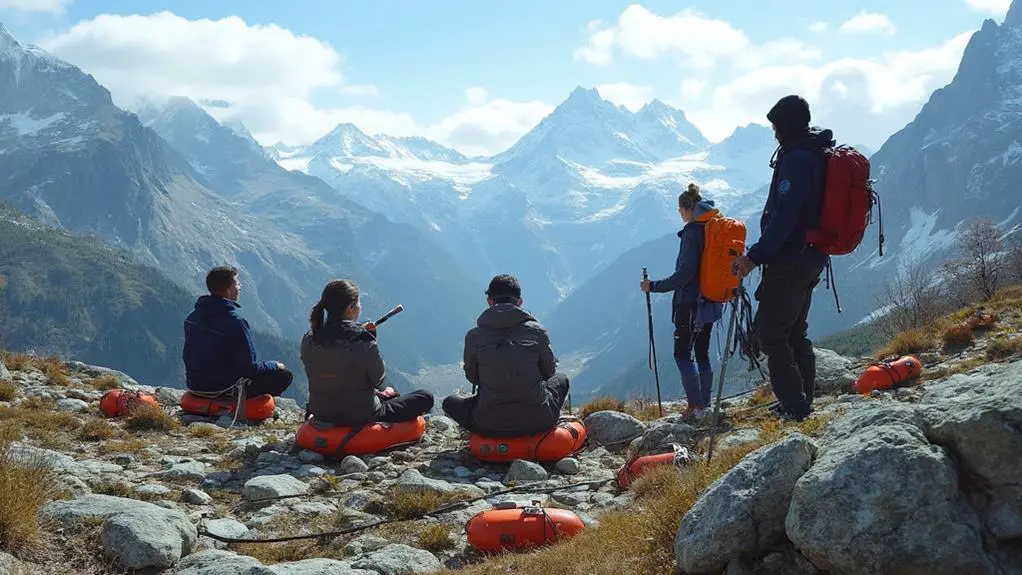Training for high-altitude hiking requires a strategic focus on strengthening both lungs and legs to conquer challenging terrains. Strength training exercises like squats, lunges, and step-ups are essential for developing leg power and endurance. Enhance lung capacity through regular aerobic activities and breathing exercises, such as diaphragmatic breathing, to optimize oxygen efficiency. Consistent cardio and structured altitude simulation sessions further solidify your respiratory capacity. Embracing pre-acclimatization techniques, like "climb high, sleep low," will aid in reducing altitude sickness. As you gear up to reveal more insights, remember that patience and consistency are your allies in mastering high-altitude adventures.
Key Takeaways
- Engage in regular aerobic exercises to boost lung capacity by 5 to 15%.
- Perform strength training exercises like squats, lunges, and step-ups to build leg strength.
- Practice diaphragmatic breathing to improve oxygen efficiency and breathing control.
- Incorporate stair climbing and hill workouts for enhanced leg strength and endurance.
- Utilize rhythmic breathing techniques during workouts to optimize lung function at high altitudes.
Understanding High Altitude Effects
Confronting the challenges of high-altitude hiking requires a deep understanding of how the body responds to reduced oxygen levels and decreased air pressure. At heights above 2,500 meters (8,200 feet), the risk of altitude sickness becomes a real concern. Symptoms such as headache, nausea, and fatigue are common as the body struggles to adjust to the diminished oxygen levels.
As heights climb beyond 3,658 meters (12,000 feet), the risk increases, and the ability to acclimatize diminishes, presenting severe physiological challenges.
To effectively counter these effects, it is essential to acknowledge the body's natural adaptation mechanisms. Increased breathing rates and raised heart rates are the body's immediate response to lower oxygen levels, aimed at enhancing oxygen uptake. Factors like age, fitness level, and genetic predisposition greatly influence how individuals cope with these challenges.
For those preparing for high-altitude hikes, gradual acclimatization is key. This involves spending time at intermediate altitudes to allow the body to adjust, reducing the likelihood of altitude sickness.
Practical preparation, combined with a positive mindset, can empower hikers to face these challenges and fully enjoy the breathtaking vistas that high-altitude treks offer.
Building Leg Strength

Building a solid foundation of leg strength is essential for high-altitude hiking, where the physical demands of steep ascents and prolonged efforts can be considerable. Strength training plays a significant role in preparing for such challenges. Incorporating exercises like squats, lunges, and step-ups into your routine can greatly enhance muscle endurance and power, allowing you to tackle mountainous terrain with confidence.
These exercises focus on the quadriceps and hamstrings, promoting balanced muscle development which is vital for reducing injury risk and improving overall hiking performance.
To maximize the benefits of strength training, consider adding weight training to your regimen. Gradually increasing resistance will substantially boost leg strength and stability, key components for high-altitude trekking success. Aim for at least two dedicated leg training sessions per week, ensuring a mix of compound movements and isolation exercises to target different muscle groups effectively.
Balance exercises are equally important as they enhance coordination and stability, essential for maneuvering uneven trails.
Enhancing Lung Capacity
When preparing for high-altitude hiking, enhancing lung capacity is an essential aspect that should not be overlooked. The ability to efficiently utilize oxygen is critical in thin air environments, and improving lung health can make the difference between a challenging hike and an enjoyable adventure.
Regular workouts, including aerobic exercises such as running and cycling, complemented by strength training like squats and lunges, can increase lung capacity by 5 to 15% over time.
Incorporating breathing exercises like diaphragmatic breathing and the Wim Hof Method greatly enhances oxygen efficiency. These techniques not only improve lung capacity but also promote relaxation, which is fundamental for maintaining composure in demanding conditions.
Activities such as swimming and yoga emphasize controlled breathing and enhance lung flexibility, making them excellent choices for those aiming to boost their lung health.
Moreover, stretching routines that target the shoulders, chest, and side body contribute to better lung function and stamina.
Consistently engaging in cardio and strength training three times per week is paramount for sustained improvements. By integrating these practices, hikers can optimize their lung capacity, ensuring they are well-prepared for the demands of high-altitude environments.
Effective Breathing Techniques

How can hikers optimize their performance when tackling the challenges of high-altitude environments? The answer lies considerably in mastering effective breathing techniques. At high altitudes, where oxygen levels are diminished, utilizing breathing exercises such as diaphragmatic breathing can greatly enhance oxygen utilization and maintain a calm physiological state. This is crucial for sustaining energy and mental clarity during demanding hikes.
Rhythmic patterns of breathing, such as synchronizing breaths with steps, are particularly beneficial. For example, implementing a "in for three, out for six" technique during uphill climbs can regulate breathing, maximize oxygen intake, and consequently improve endurance. This method not only aids in reducing fatigue but also boosts stamina, enabling hikers to maintain consistent progress over challenging terrains.
Incorporating breathing exercises like box breathing or alternate nostril breathing into regular training routines can further balance the respiratory system and enhance lung function, preparing the body for lower oxygen levels encountered at high altitudes.
Introducing these techniques during rest periods in interval training is an effective way to simulate the exertion of high-altitude hiking, encouraging adaptation and resilience. By integrating these strategies, hikers can face high-altitude challenges with enhanced capability and confidence.
Importance of Hydration and Nutrition
Setting out on a high-altitude hike demands meticulous attention to hydration and nutrition, given their vital roles in maintaining performance and health. At higher elevations, the body experiences increased water loss due to respiration in low-oxygen environments, necessitating effective hydration strategies.
It is essential to consume at least 3-4 liters of water daily to mitigate the risk of altitude sickness and guarantee ideal physiological function. Including electrolyte-rich beverages in your regimen can further assist in maintaining fluid balance and promoting muscle function, thanks to essential minerals like sodium, potassium, and magnesium.
Equally important is a well-planned nutritional approach to support energy demands. High-altitude hiking requires a diet rich in complex carbohydrates, proteins, and healthy fats, with a recommended 20-30% increase in caloric intake compared to sea level.
Such nutrition tips guarantee sustained energy levels and muscle endurance. Incorporating antioxidant-rich foods, such as berries and leafy greens, can combat oxidative stress and bolster lung health, critical to thriving in an oxygen-scarce environment.
Safety and Acclimatization Strategies

Maneuvering the rugged terrain of high-altitude hikes requires not just physical stamina but a strategic approach to safety and acclimatization. The acclimatization benefits are significant, as they help hikers adapt to lower oxygen levels, reducing the risk of altitude sickness.
A recommended strategy is to "climb high, sleep low," which involves ascending to higher altitudes during the day and descending for rest. This method effectively reduces bodily stress by providing adequate recovery time at lower elevations. Before tackling peaks like Mt. Kilimanjaro, spending at least one week acclimatizing can greatly enhance your success in adapting to high altitudes.
To guarantee safety and optimize acclimatization, consider the following strategies:
- Gradual Ascent: Symptoms of altitude sickness, such as headaches and dizziness, can occur above 8,000 feet (2,400 meters). Gradual ascent is vital to allow your body to adjust to the changing environment.
- Pre-Acclimatization Techniques: Utilizing hypoxic sleeping conditions or altitude simulation tents at home can prepare your body for high-altitude environments, potentially alleviating altitude sickness symptoms.
- Hydration and Lifestyle: Maintain proper hydration and avoid alcohol to improve sleep quality at altitude, supporting acclimatization and reducing health risks during your hike.
Frequently Asked Questions
How Can I Strengthen My Lungs for High Altitude?
To strengthen your lungs for high altitude, incorporate breathing exercises, such as diaphragmatic breathing, into your routine. These practices enhance oxygen utilization and support altitude acclimatization, allowing for improved respiratory function and greater endurance during high-altitude activities.
How to Improve Lung Capacity for Hiking?
To improve lung capacity for hiking, integrate breathing exercises, such as diaphragmatic breathing, alongside endurance training like running or cycling. This combination enhances oxygen absorption and stamina, empowering you to confidently tackle challenging trails with increased respiratory efficiency.
How Do You Get in Shape for High Altitude?
To effectively get in shape for high altitude, prioritize endurance training through consistent aerobic exercises and incorporate strength workouts. Implement acclimatization strategies by gradually increasing elevation exposure, fostering physiological adaptations essential for high-altitude performance and reduced altitude sickness risk.
How Do You Stop Shortness of Breath at High Altitudes?
To mitigate shortness of breath at high altitudes, employ acclimatization techniques by gradually increasing elevation exposure and incorporate breathing exercises, such as diaphragmatic breathing, to enhance oxygen utilization, ensuring a more comfortable and efficient hiking experience.
Conclusion
Training for high-altitude hiking demands a thorough approach that encompasses building leg strength, enhancing lung capacity, mastering effective breathing techniques, and adhering to proper hydration and nutrition. Understanding the physiological effects of high altitude is essential for developing appropriate acclimatization strategies and ensuring safety. By systematically addressing these components, hikers can optimize performance and resilience in challenging environments. Commitment to preparation not only mitigates potential risks but also enhances the overall hiking experience, enabling the achievement of personal goals and exploration of new heights.